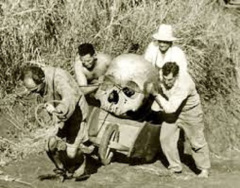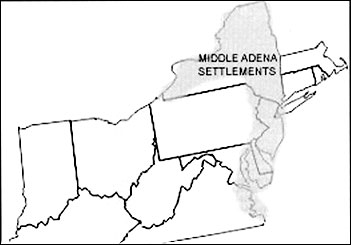The LegendFrom Henry Schoolcraft, noted scholar on the subject, we have this reference to a most antique and mysterious tribe or nation:
Schoolcraft, referring to the entire Appalachian chain as the Alleghenies, is believed to have secured his information specifically from the writings of John Heckewelder, assistant to the Moravian missionary David Zeisberger, himself from Moravia. Together Zeisberger and Heckewelder founded the town of Shoenbrun, near present day New Philadelphia, Ohio. They successfully converted as many as 400 Delaware to the Christian faith through peaceful persuasion, doubtless making many close allies during the work. Heckewelder’s account may not be the only one concerning prehistoric America, but it is surely reliable for the conveyance of the tradition of the Delaware, who were derived, however indirectly, of the venerable Lenni Lenape. Heckewelder writes regarding the Allegewi:
Many centuries ago, the Lenni Lenape, for some undisclosed reason, moved en masse from the western half of the present day United States, toward the east. As the legend goes, these people found themselves at the shore of the Mississippi, the white man’s enunciation of their Namesi Sipu, River of Fish. There they met up with the Mengwe, who had come from a bit further north and closer to the source of the Namesi Sipu, perhaps the present-day Missouri. It was a meeting of destiny, and was, at that time, a peaceful one. The Lenape sent out their scouts across the broad current. James A. Jones, another writer of the time, relates of the occasion of the safe return of these “spies” for the Lenape, having reconnoitered the eastern side of the Mississippi:
The legend moves very quickly then. In the words of Heckewelder:
While one should always be aware that history as related by the victorious side may not be history as it actually occurred, never the less the resultant war is related as eventually becoming an overwhelming loss for the Alleghans. Whether the Lenape were considered deceitful in not disclosing their vast hoard is perhaps irrelevant. While one account says the Allegewi were extirpated, another relates of their escape down the Mississippi. The Lenni Lenape, having made an alliance with the Mengwe, took many years, and through a great loss of people, claim to have finally defeated the
Alleghans through force of arms. As noted again later, these Mengwe followed after the Lenape in war, staying back to avoid injury as much as they might. Perhaps this was on account of their agreement, that upon the defeat of the Allegheny people, the Lenni Lenape would take for themselves the heartland of their adversaries, while the Mengwe would be awarded the lands to the north, nearer to the Great Lakes, and the latitude whence they came. As the legend completes itself, the two triumphant tribes lived together in peace and cooperation for many centuries. But having done this, it is related that the lands to the east were found to be uninhabited by any enemies, and that they were rich and beautiful, the destiny of the Great Spirit for the people. On this account, they ultimately moved eastward, leaving again the Ohio country comparatively vacant. Out of these ancient people of the Lenape (who are assumed to have bred with the Mengwe only to a lesser extent at the beginning), no less than 40 tribes are said thereafter to have arisen. In hindsight, not only would this have required a great number of generations, but also it may explain the difficulty in DNA pattern matching with an ancestral people living millennia before. As for the Mengwe, their destiny as the Iroquois is well known, being that of the Confederation of the Five Tribes, and then the Tuscorora [sic]. Later of course, the Lenni Lenape, as the Delaware, became bitter enemies with the Iroquois. David Cusick, a Tuscorora [sic] by birth, writes in 1825 that among the legends of ancient stock, there was a powerful tribe called Ronnongwetowanca. They were giants, and had a “considerable habitation.” He says that when the Great Spirit made the people, some of them became giants. The giants were said to have had a “silly” mode of attack, waiting until their intended victim was not expecting anything. After a time, and having endured the outrages of these giants, it is said that the people ended together, and through the final force of about 800 warriors, successfully annihilated all of the abhorrent Ronnongwetowanca people. After that, it was said that there were no giants anywhere. This was supposed to have happened around 2,500 winters before Columbus discovered America, i.e. around 1000 B.C.E.-the time that the Adena seem to have arrive in the Ohio Valley. There appears to be coincidental links, combining legend and archaeology, between the possible existence of a great nation having giants among their people, their struggle in war, and the beginning time of the Adena in the Ohio Valley. It is no great stretch to reason the possibility that mound construction, especially mortuary, was not necessarily transferred to the Ohio region from the southeast region. In point of view, there may be logic in it. Heckewelder writes:
Such an after-battle chore would be the warriors’ choice. Mound building of this type is as ancient a practice as can be imagined. It was not only clean, but was practical, and probably respectable as well. Then from where the Mengwe are thought to have come before they joined the Lenni Lenape, i.e. from the region of the Mississippi’s source confluence at the Dakota Missouri, we have this, originally entitled “A Prehistoric Cemetery:”
Mounds wherein the dead were placed and covered with earth to avoid open decay and the diseases associated with it are as easy to accept as yesterday’s news. This is a possible explanation for the origin of mounds for the honored dead-the slain heroes and men sacrificed in discharging the dreadful arts of war. Through the eyes of the participant warriors, such a battlefield practice may have served as a fitting memorial, reminding them of their struggles. Later, it could have been reenacted in quieter surroundings by the Adena. Such mounds or cemeteries as quoted above, holding the remains of people of above average stature, even giants, possibly pushes the practice of moundbuilding back into an undisclosed period of prehistory. The inclusion of broken pottery in the above mound is similar to the Adena practice of placing broken pottery in the fill of their mounds (Dragoo. Mounds For the Dead, 1963, p.246). Could this be symbolic of the soul’s “vessel” being broken? Because Webb and Snow (Adena People, 1981 p.314-15) are emphatic that the Adena showed no signs of being engaged in any warfare practice at all, one might assume that the practice was pre-Adena, re-enacted to become as tradition by them.
|












